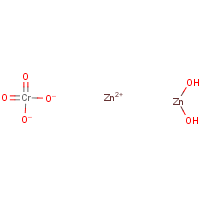Zinc chromate hydroxide
Agent Name
Zinc chromate hydroxide
CAS Number
15930-94-6
Formula
Cr-O5-Zn2.H2-O
Major Category
Metals

Synonyms
Buttercup Yellow; CI Pigment Yellow 36; Chromic acid (H6CrO6), zinc salt (1:2); Chromic acid, zinc hydroxide hydrate (1:2:2:1); Chromic acid, zinc salt (1:2); Chromium(6+) zinc oxide hydrate (1:2:6:1); Zinc chromate oxide (Zn2(CrO4)O), monohydrate; Zinc chromate(VI) (Zn2(CrO4)O) (6CI); Zinc chromate(VI) hydroxide; Zinc yellow; [ChemIDplus]
Category
Chromium Compounds, Inorganic
Description
Solid; Hydrate: Yellow solid; Practically insoluble in water (0.04 g/L); [HSBD]
Sources/Uses
Used as a pigment in corrosion-resistant primers, paints, varnishes, oil colors, linoleum, and rubber; [HSDB]
Comments
See "Zinc chromate." See "Chromic acid." See "Chromium" and linked occupational diseases.
Biomedical References
Exposure Assessment
BEI
For chromium (VI), water-soluble fume: Total Cr in urine = 10 ug/L (increase during shift) or 25 ug/L (end of shift at end of workweek)
Bioaccumulates
Yes
TLV (ACGIH)
0.0001 mg/m3, as Cr(VI), inhalable particulate matter
STEL (ACGIH)
0.0005 mg/m3, as Cr(VI), inhalable particulate matter
PEL (OSHA)
0.005 mg/m3, as Cr(VI)
MAK
0.1 mg/m3 (respirable fraction), 2 mg/m3 (inhalable fraction)-for Zn inorg. Compds., Ceiling(OSHA) = 0.1 mg/m3, as CrO3
IDLH (NIOSH)
15 mg/m3, as Cr(VI)
Adverse Effects
Skin Sensitizer
Yes
Asthma
Yes
Hepatotoxin
Hepatoxic (a) from occupational exposure (secondary effect) or (b) in animal studies or in humans after ingestion
Nephrotoxin
Yes
Dermatotoxin
Skin burns
IARC Carcinogen
Established
NTP Carcinogen
Human carcinogen
ACGIH Carcinogen
Confirmed Human
Diseases, Processes, and Activities Linked to This Agent
Diseases
Occupational diseases associated with exposure to this agent:
Processes
Industrial Processes with risk of exposure:
Activities
Activities with risk of exposure: